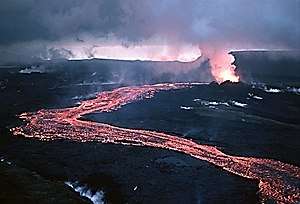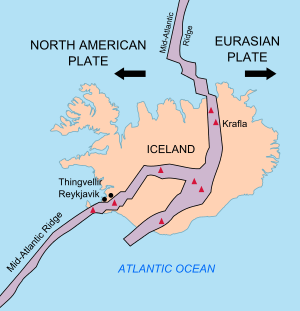Iceland hotspot



The Iceland hotspot is a hotspot which is partly responsible for the high volcanic activity which has formed the island of Iceland.
Description
Iceland is one of the most active volcanic regions in the world, with eruptions occurring on average roughly every three years (in the 20th century there were 39 volcanic eruptions on and around Iceland). About a third of the basaltic lavas erupted in recorded history have been produced by Icelandic eruptions. Notable eruptions have included that of Eldgjá, a fissure of Katla, in 934 (the world's largest basaltic eruption ever witnessed), Laki in 1783 (the world's second largest), and several eruptions beneath ice caps, which have generated devastating glacial bursts, most recently in 2010 after the eruption of Eyjafjallajökull.
Iceland's location astride the Mid-Atlantic Ridge, where the Eurasian and North American Plates are moving apart, is partly responsible for this intense volcanic activity, but an additional cause is necessary to explain why Iceland is a substantial island while the rest of the ridge mostly consists of seamounts, with peaks below sea level.
As well as being a region of higher temperature than the surrounding mantle, it is believed to have a higher concentration of water. The presence of water in magma reduces the melting temperature, which may also play a role in enhancing Icelandic volcanism.
Theories of causation
There is an ongoing discussion about whether the hotspot is caused by a deep mantle plume or originates at a much shallower depth.[1] Recently, seismic tomography studies have found seismic wave speed anomalies under Iceland, consistent with a hot conduit 100 km across that extends to the lower mantle.[2]
Some geologists have questioned whether the Iceland hotspot has the same origin as other hotspots, such as the Hawaii hotspot. While the Hawaiian island chain and the Emperor Seamounts show a clear time-progressive volcanic track caused by the movement of the Pacific Plate over the Hawaiian hotspot, no such track can be seen at Iceland.
It is proposed that the line from Grímsvötn volcano to Surtsey shows the movement of the Eurasian Plate, and the line from Grímsvötn volcano to Reykjanes volcanic belt shows the movement of the North American Plate.[3]
Mantle plume theory
It is believed that a mantle plume underlies Iceland, of which the hotspot is thought to be the surface expression, and that the presence of the plume enhances the volcanism already caused by plate separation. Additionally, flood basalts on the continental margins of Greenland and Norway, the oblique orientation of the Reykjanes Ridge segments to their spreading direction, and the enhanced igneous crustal thickness found along the southern Aegir and Kolbeinsey Ridges may be results of interaction between the plume and the Mid-Atlantic Ridge.[4] The plume stem is believed to be quite narrow, perhaps 100 km across and extending down to at least 400–650 km beneath the Earth's surface, and possibly down to the core-mantle boundary, while the plume head may be > 1,000 km in diameter.[4][5]
It is suggested that the lack of a time-progressive track of seamounts is due to the location of the plume beneath the thick Greenland craton for ~ 15 Myr after continental breakup,[6] and the later entrenchment of the plume material into the northern Mid-Atlantic Ridge following its formation.[4]
See also
References
Notes
- ↑ Foulger 2005.
- ↑ Rickers, Florian; Fichtner, Andreas; Trampert, Jeannot (1 April 2013). "The Iceland–Jan Mayen plume system and its impact on mantle dynamics in the North Atlantic region: Evidence from full-waveform inversion". Earth and Planetary Science Letters. 367: 39–51. Bibcode:2013E&PSL.367...39R. doi:10.1016/j.epsl.2013.02.022. Retrieved 6 June 2017.
- ↑ Morgan & Morgan 2009.
- 1 2 3 Howell, Samuel M.; Ito, Garrett; Breivik, Asbjørn J.; Rai, Abhishek; Mjelde, Rolf; Hanan, Barry; Sayit, Kaan; Vogt, Peter (2014-04-15). "The origin of the asymmetry in the Iceland hotspot along the Mid-Atlantic Ridge from continental breakup to present-day". Earth and Planetary Science Letters. 392: 143–153. Bibcode:2014E&PSL.392..143H. doi:10.1016/j.epsl.2014.02.020.
- ↑ Dordevic, Mladen; Georgen, Jennifer (2016-01-01). "Dynamics of plume–triple junction interaction: Results from a series of three-dimensional numerical models and implications for the formation of oceanic plateaus". Journal of Geophysical Research: Solid Earth: 2014JB011869. Bibcode:2016JGRB..121.1316D. doi:10.1002/2014JB011869. ISSN 2169-9356.
- ↑ Mihalffy, Peter; Steinberger, Bernhard; Schmeling, Harro (2008-02-01). "The effect of the large-scale mantle flow field on the Iceland hotspot track". Tectonophysics. Plate movement and crustal processes in and around Iceland. 447 (1–4): 5–18. Bibcode:2008Tectp.447....5M. doi:10.1016/j.tecto.2006.12.012.
Bibliography
- Allen, R. M.; Nolet, G.; Morgan, W. J.; et al. (1999). "The thin hot plume beneath Iceland". Geophysical Journal International. 137 (1): 51–63. Bibcode:1999GeoJI.137...51A. CiteSeerX 10.1.1.412.695. doi:10.1046/j.1365-246x.1999.00753.x.
- Foulger, Gillian R. (February 8, 2005). "Iceland & the North Atlantic Igneous Province". Retrieved November 19, 2014.
- Foulger, G. R.; Anderson, D. L. (2005). "A cool model for the Iceland hotspot". Journal of Volcanology and Geothermal Research. 141 (1–2): 1–22. Bibcode:2005JVGR..141....1F. doi:10.1016/j.jvolgeores.2004.10.007.
- Morgan, W. Jason; Morgan, Jason Phipps (2009). "Plate velocities in hotspot reference frame: electronic supplement" (PDF). In Foulger, Gillian R.; Jurdy, Donna M. Plates, Plumes, and Planetary Processes (P4). Retrieved November 19, 2014.
- Nichols, A. R. L.; Carroll, M. R.; Höskuldsson, Á. (2002). "Is the Iceland hot spot also wet? Evidence from the water contents of undegassed submarine and subglacial pillow basalts". Earth and Planetary Science Letters. 202 (1): 77–87. Bibcode:2002E&PSL.202...77N. doi:10.1016/S0012-821X(02)00758-6.